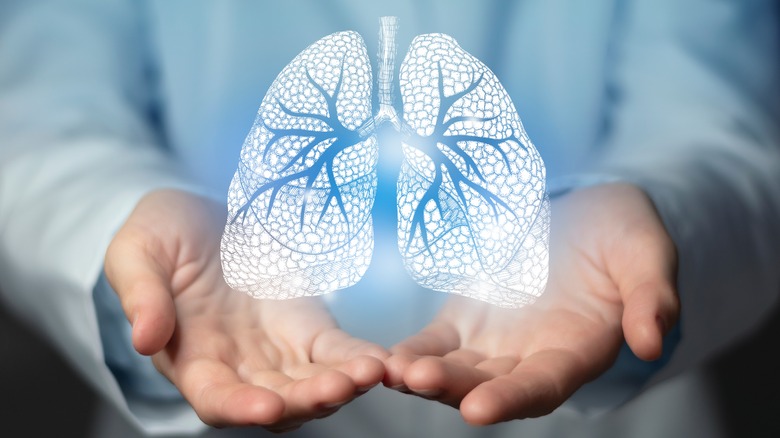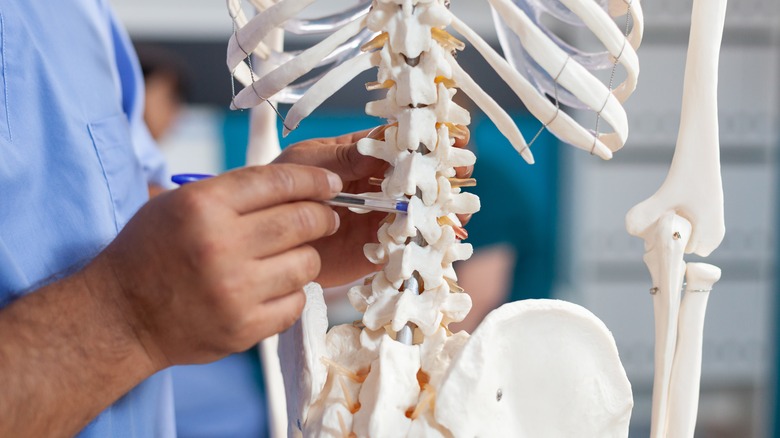Here's What May Be Causing Your Sternum Pain
According to Physiopedia, around 20% to 30% of hospital admissions in the U.S. are due to pain in the chest area. Although pain in the chest is often confused with being heart-related, it can also be linked to the sternum. This is the flat bone in the center of your chest, consisting of the manubrium, body, and xiphoid process, per Healthline.
The sternum protects the torso and connects other essential bones and muscles in the skeletal system. Any pain or trauma in this area can make day-to-day living uncomfortable. According to Healthline, sternum pain can be elusive — it might be difficult to determine whether your chest pain stems solely from the sternum or is due to a more critical issue like a heart attack.
If it's crucial to seek early medical care when experiencing unexplained pain within your chest area. This is especially true if the pain is accompanied by sweating, nausea, dizziness, or breathing difficulties. If the pain is mild, there may be no cause for alarm. According to MedicalNewsToday, sternum pain is usually not serious. Read on for the possible causes of sternum pain.
Costochondritis is most common cause of sternum pain
According to Healthline, costochondritis, a condition characterized by sharp pains in the sternum region, is the most common cause of sternum pain. This condition accounts for 10% to 30% percent of all chest pain in children, who may easily develop costochondritis from carrying heavy book bags over one shoulder, per WebMD.
While doctors may not know exactly what causes the condition, it's often associated with trauma or a severe illness (via Mayo Clinic). According to the National Health Service (NHS), trauma may stem from a chest injury and various underlying conditions like arthritis and fibromyalgia can cause costochondritis, says the NHS. Also, if you've recently experienced heavy coughing or you have inflammation of the nervous system, costochondritis might come as a result (via the Winchester Hospital).
According to the hospital, women are more likely to develop the condition. The risk might be higher in those who participate in high-impact sports like rowing. You might also be at a higher risk for this condition if you regularly do repetitive activities involving the upper body, says the hospital. People who have a respiratory infection caused by a virus or a bacterial infection — especially those who use IV drugs — might be at greater risk, as well (via WebMD).
Costochondritis causes and symptoms
Even though some of these causes may look critical, costochondritis isn't fatal. Nevertheless, the symptoms can make it uncomfortable to undertake daily activities. According to the Cleveland Clinic, costochondritis may start with pain on the left side of your chest, spreading to the rest of your chest and sometimes, the stomach or back. This pain usually worsens when costochondritis patients partake in strenuous exercises, heavy lifting, or severe coughing, says MedicalNewsToday. Since these symptoms already make your chest feel heavy, any additional pressure exerted on the chest might cause more pain.
According to Medical News Today, costochondritis symptoms may mirror those of Tietze syndrome, a rare condition that's more severe. Therefore, it's crucial to consult with your doctor to ensure these symptoms are checked and diagnosed as early as possible. According to a 2009 article published by the American Family Physician, evaluation is very important if you're over 35 years or if you have high cholesterol, diabetes, or high blood pressure.
Costochondritis diagnosis and treatment
To diagnose costochondritis, your doctor might look into your medical history and physically examine your chest. Further testing might be needed to rule out and distinguish costochondritis from other serious causes of chest pain, especially for people with other existing health conditions, says the American Family Physician. In such instances, an electrocardiograph and a chest radiograph might be required.
To treat costochondritis at home, you can apply heat to the affected area using a warm compress, per MedicalNewsToday. Physical therapy might also come in handy to ease tension in the chest wall, per the source. If a cough triggers your condition, cough suppressants can also help reduce chest pain in the cartilage, per Medical News Today. For more painful symptoms, your doctor might prescribe a nonsteroidal anti-inflammatory drug (NSAID) like naproxen, meloxicam, or ibuprofen (via this 2022 study published in the journal StatPearls). According to the study, NSAIDs may not work well for people with acute and chronic kidney conditions. Medical News Today also warns against dispensing NSAIDs like aspirin to children under 18 due to the increased risk for Reye's syndrome.
If none of the above treatments work, your doctor might recommend using steroids or transcutaneous electrical nerve stimulation (TENS), which subjects the affected area to mild electric current, Healthline says. A surgical procedure to remove the sore cartilage is the last resort if sternum pain persists (via WebMD).
Musculoskeletal causes of sternum pain
Certain musculoskeletal conditions can trigger chest pain and sternum pain. One example is a sternoclavicular joint injury. As one of four joints that complete the shoulder, the sternoclavicular joint is located at the meeting point of the clavicle (collarbone) and sternum, per the American Academy of Orthopaedic Surgeons. Injury to this joint can cause pain which often worsens when you try to move your arm.
Trauma to the collarbone can also trigger sternum pain (via Healthline). This kind of trauma often comes with intense pain when you attempt to move your arm. Furthermore, your shoulder might sag forward, and you may experience bruises or bumps around the affected area.
Sternum fractures caused by car accidents, sports injuries, or wrongfully administered cardiopulmonary resuscitation (CPR) are other possible causes of sternum pain (via WebMD). Common symptoms of a sternum fracture include pain in the chest when you attempt to breathe, cough, or sneeze.
Gastrointestinal and respiratory causes of sternum pain
The sternum's position can make it susceptible to certain gastrointestinal conditions. According to Healthline, the sternum sits in front of several major digestive organs, making it easier for various digestive-health-related issues to trigger sternum pain. The source also confirms that conditions that affect your lungs, windpipes, and other respiratory organs may lead to sternum pain. Typical examples include gastroesophageal reflux disease (GERD), a chronic form of acid reflux, per Healthline. According to the Cleveland Clinic, acid reflux is the most common cause of non-cardiac chest pain. About 50% to 60% of non-cardiac chest pain is due to acid reflux. Besides chest tightness, acid reflux severe can also cause burning in your chest and difficulty swallowing.
Bronchitis, another common cause of sternum pain, is a respiratory condition caused by inflammation of the bronchial tubes that bring air into the lungs, says Healthline. It affects approximately 10 million people in the United States, especially adults between 44 and 65 years (via American Lung Association). Besides chest pain, other common symptoms include breathing difficulties and wheezing, says Healthline.
Lastly, panic attacks are another likely cause of sternum pain, says Healthline. According to a 2002 study published in The Primary Care Companion to the Journal of Clinical Psychiatry, hyperventilation, a mainstay of panic attacks, can manifest through the non-cardiac category, leading to chest pains or spasms, per the study.






